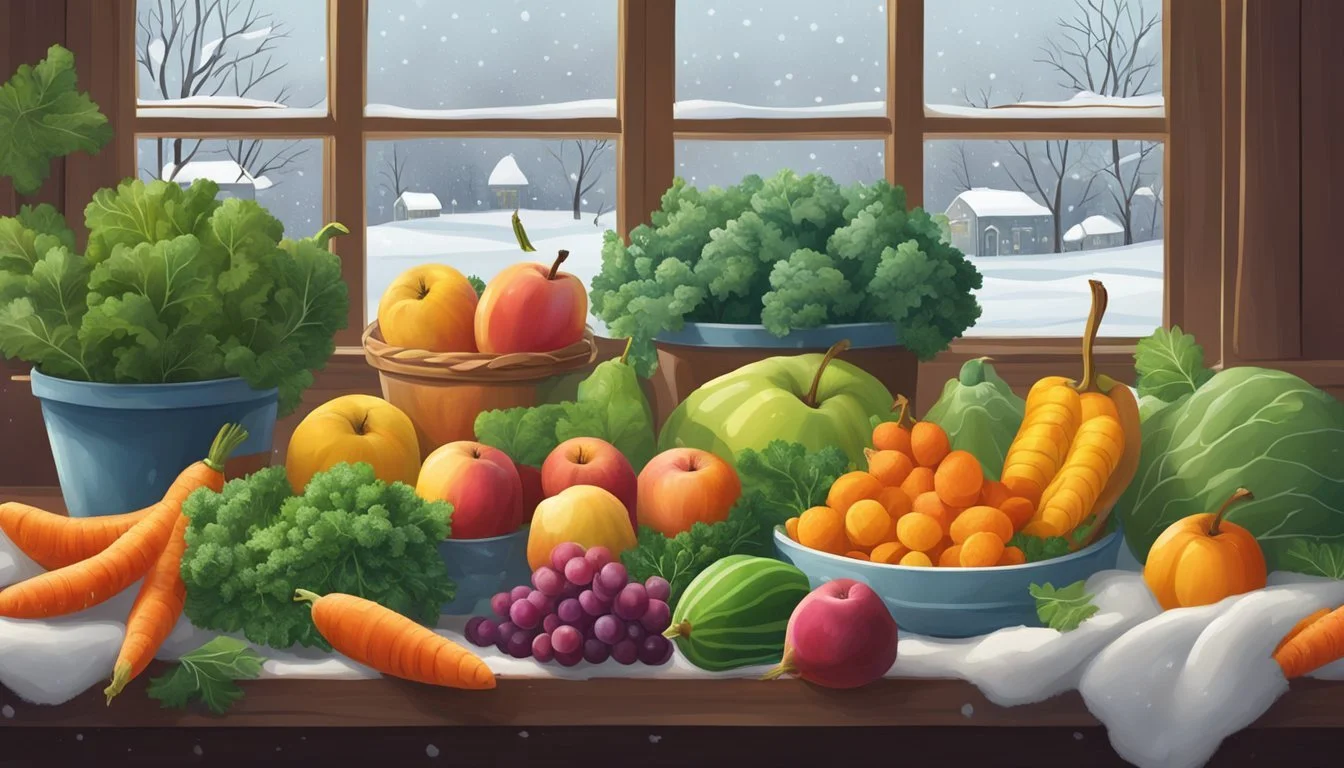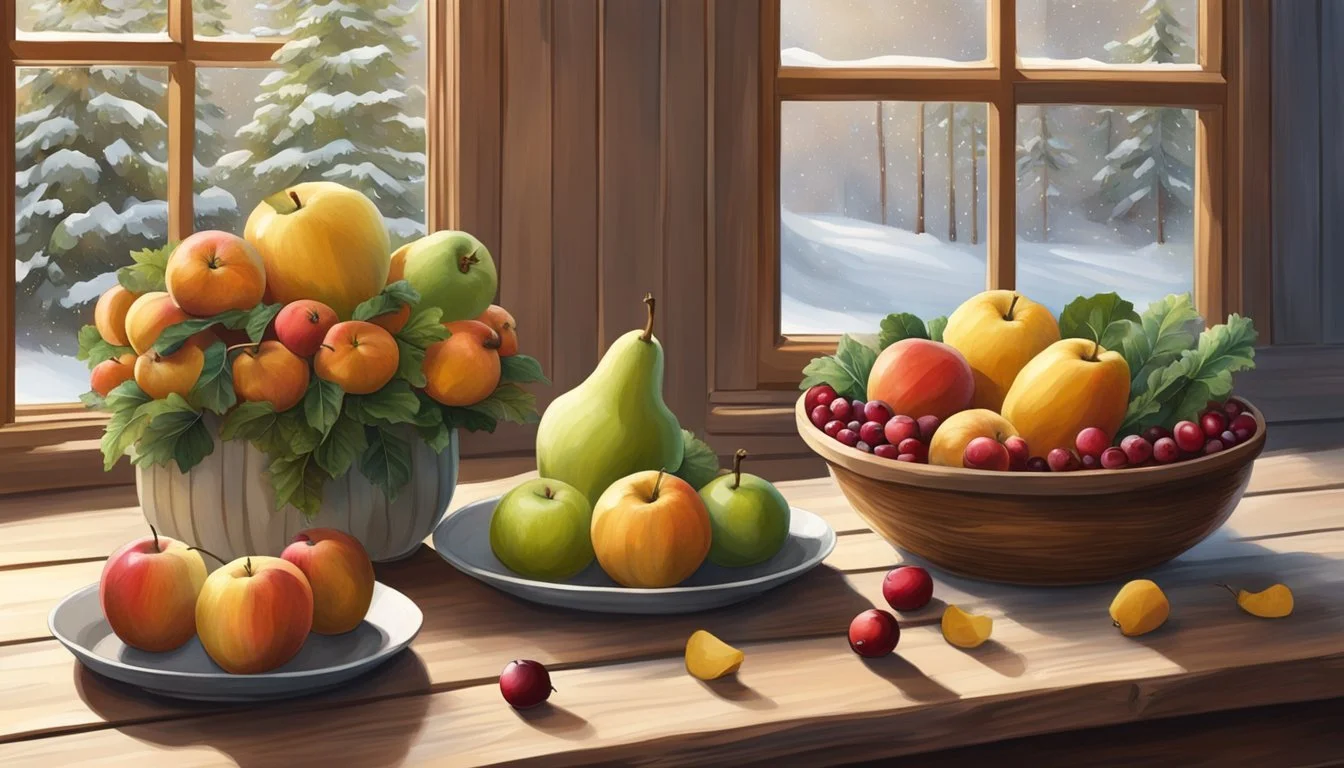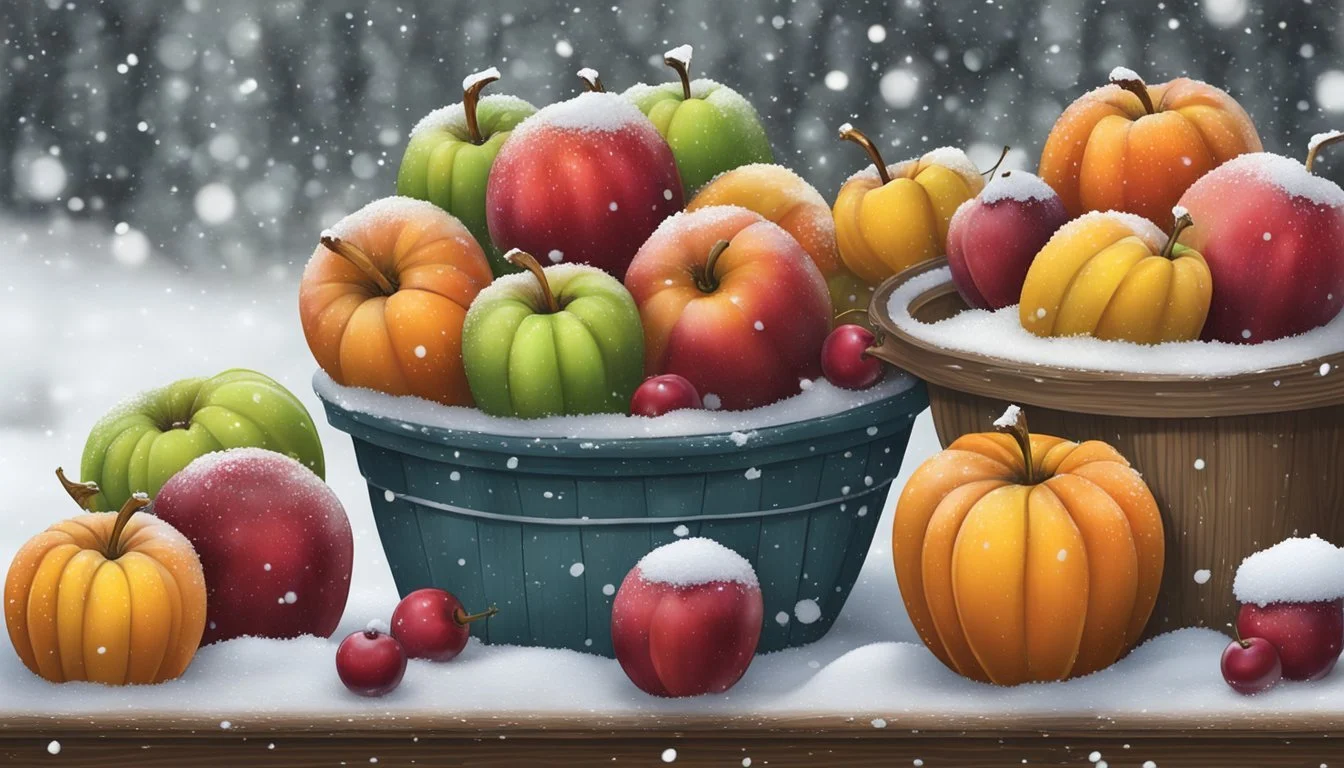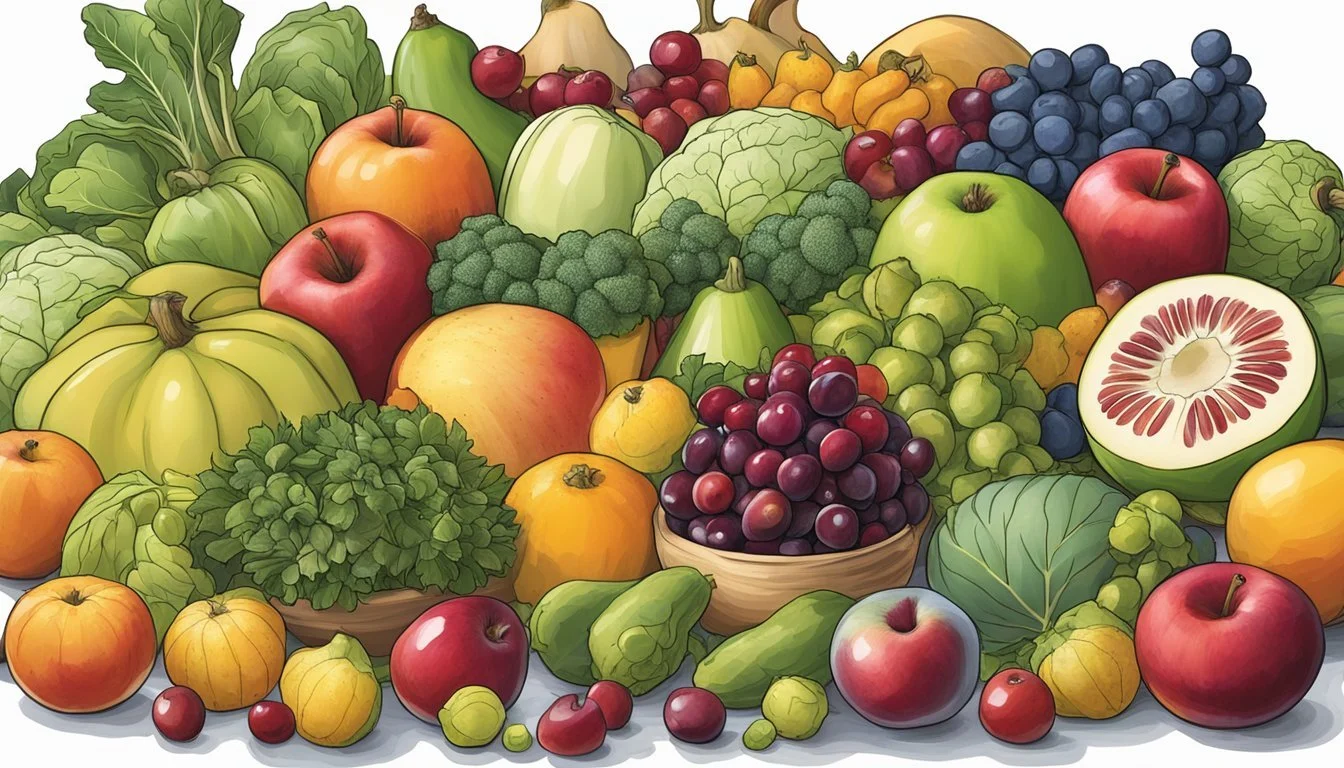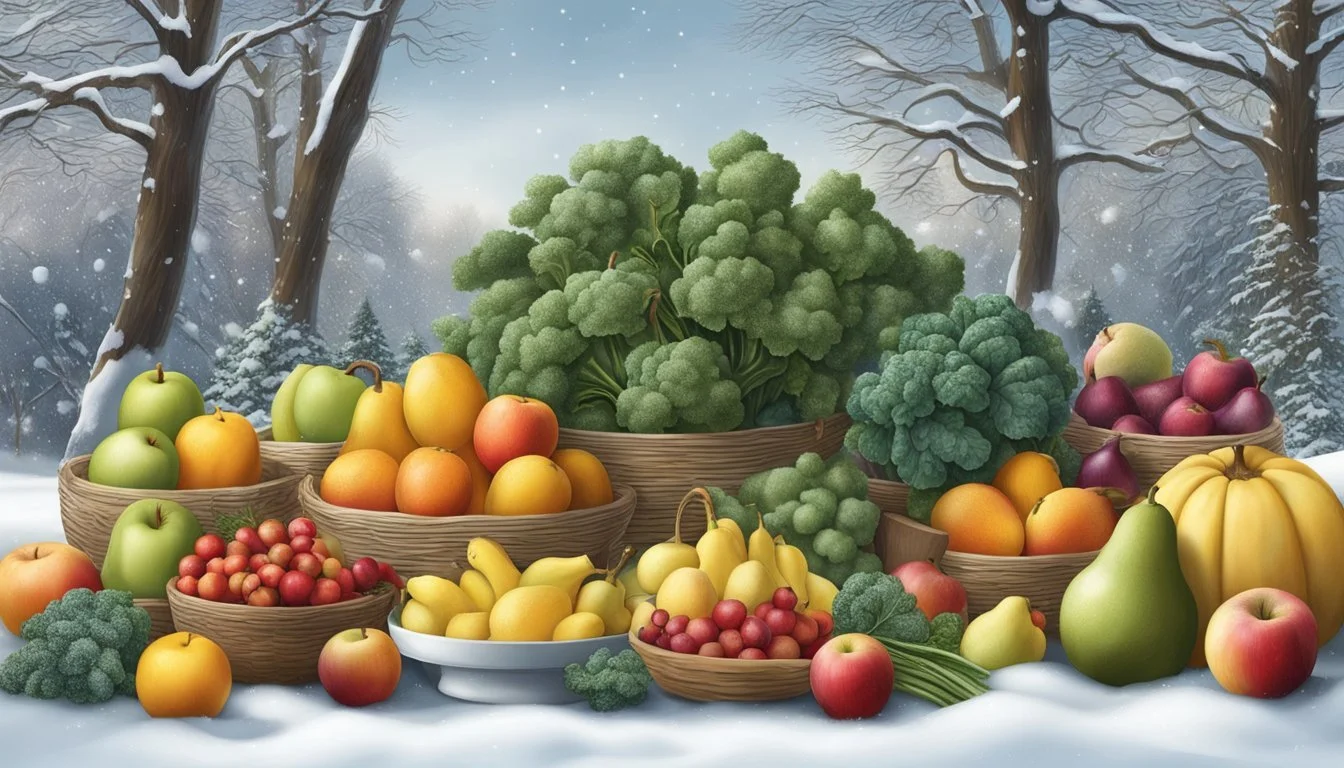Maine Seasonal Fruit & Vegetables in December
A Guide to Winter Produce
This Article is Part of our Maine Seasonal Fruit & Veg Calendar
December in Maine hosts a landscape preparing for the deep chill of winter, but this does not mean the local produce is any less abundant. Residents and visitors alike can find a variety of fruits and vegetables that are in season, thanks to dedicated farmers who employ methods to extend the growing cycles. The range of in-season produce includes hearty root vegetables and crisp, storage-friendly fruits which are emblematic of the region’s agricultural resilience.
Root vegetables like beets, carrots, and celeriac thrive in the cold soil, storing energy in their roots which results in a concentrated sweetness that is a staple of winter fare. Stored apples, rich in flavor from the late harvest, continue to grace market stands, side by side with robust winter greens that endure the colder temperatures. These products not only exemplify the seasonality of Maine’s agriculture but also the ingenuity of its farming practices.
Local markets in December showcase these seasonal offerings, providing an opportunity for consumers to support the local economy while enjoying produce that’s fresh and full of flavor. The colder season brings a shift in available produce, featuring the likes of garlic, leeks, and cabbage – vegetables that can withstand the frost and offer nourishing options for cold-weather meals. As the year winds down, Maine’s agricultural bounty remains rich and varied, ensuring there’s plenty to savor even in the midst of winter.
Seasonal Overview
In Maine, December brings the close of fall harvests and ushers in the winter season. With frost settling across the state, only hardy, cold-tolerant produce remains available. This time of year presents a distinct selection of fruits and vegetables sustained by the unique Maine climate.
The Role of Climate in Seasonality
Maine's climate, characterized by cold winters, significantly shapes its agricultural seasonality. The state's winter season typically includes low temperatures and substantial snowfall, affecting which produce can survive and thrive. December, firmly within this cold season, offers a limited but noteworthy range of produce. Farmers in Maine often extend the availability of crops through techniques such as indoor growing, hoop houses, and root cellaring.
Importance of Eating Seasonally
Eating seasonally supports not only the local economy but also enhances the nutritional value and taste of produce. In December, Maine consumers have access to winter-harvested vegetables and stored harvest from the fall. This ensures the availability of fresh, vitamin-rich food options despite the challenging growing conditions.
The fruits and vegetables typically available in Maine during December include:
Fruits: Apples (stored from fall harvest)
Vegetables:
Beets (how long do beets last?)
Cabbage
Carrots
Garlic
Leeks
Onions
Potatoes (What wine goes well with potatoes?)
Winter Squash
These items reflect the robust nature of Maine's agricultural offerings as they transition into the winter season.
Seasonal Fruits
December in Maine heralds the tail end of the harvest season, yet certain hardy fruits remain in abundance. The state's cool climate favors fruits such as apples and cranberries, which not only survive but thrive in the colder temperatures.
Apples Varieties and Uses
Maine offers an array of apple varieties that flourish during the winter months. Popular types include:
McIntosh: Ideal for snacking and applesauce.
Cortland: Excellent for salads and cooking due to their ability to retain shape.
Honeycrisp: Known for their crisp texture, perfect for eating fresh.
Northern Spy: A favorite for pies and baking because of their tart flavor.
Residents often use these apples for making festive treats like pies, crisps, and ciders during the holiday season.
Late Season Berries
While most berries have concluded their season, cranberries offer a burst of tartness in the winter landscape. These berries are typically harvested from mid-September through November, but their hardiness allows them to be stored and sold through December, making them a seasonal staple often used in holiday recipes and decorations.
Other Seasonal Fruits
Apart from apples and cranberries, December fruit options are limited due to the harsh Maine winters. However, local farmers and producers often offer preserves, jams, and jellies made from the summer and fall harvests, extending the availability of fruit products through the winter. These preparations capture the essence of seasonal fruits such as blueberries, raspberries, and strawberries, and they become valuable commodities in local markets during the colder months.
Seasonal Vegetables
In December, Maine's harsh winters bring a selection of hearty vegetables that can withstand the cold. The seasonal produce primarily includes root vegetables, resilient leafy greens, and robust squash and gourds.
Root Vegetables
Root vegetables thrive in Maine's climate, offering a bounty even in the chill of December.
Carrots: Sweet and crunchy, these are versatile for both raw and cooked dishes.
Beets: Deeply colored with a rich, earthy flavor, beets are available fresh from local sources.
Onions: A foundational ingredient in many recipes, onions offer flavor and sustenance.
Parsnips: Less common but equally hearty, parsnips bring a sweet, nutty taste to a variety of dishes.
Potatoes: These are a staple in Maine, with many varieties available, from russets to fingerlings.
Winter Hardy Greens
Greens that can endure the cold are limited but available. They are typically hardier and have a more robust flavor than those found in the summer months.
Kale: (What wine goes well with kale?) Known for its nutritional value, kale can survive winter's frost, becoming even sweeter after a hard freeze.
Collards: These greens are well-suited for long, slow cooking methods popular during the winter.
Squash and Gourds
Squash and gourds are emblematic of winter comfort foods, with varieties stored well into the winter months.
Winter Squash: Butternut, acorn, and delicata squash provide dense, sweet flesh that is perfect for roasting or in soups.
Pumpkins: While often associated with autumn, many pumpkin varieties can be stored and used throughout December for both culinary and decorative purposes.
These vegetables are representative of what one can typically expect from Maine's farmers and markets during the winter season.
Fresh Produce Availability
In December, the range of fresh produce from Maine's diligent farmers and markets is more limited due to the cold climate, but certain hearty items are still harvested and available locally. Consumers can visit farmers' markets to find a selection of late-season and storage crops that have been carefully preserved to maintain their quality.
Vegetables:
Root vegetables such as carrots and beets maintain excellent quality through cold storage.
Cabbage and leeks can also be found, often kept in ideal conditions to ensure freshness.
Storage of potatoes and winter squash allows them to be available well into the winter months.
Fruits:
Apples, in various varieties, are commonly stored in controlled environments to extend their availability after harvest.
While the variety of fresh produce in December may not be as extensive as during the peak growing season, the items available are often characterized by their robust flavors and nutrient density. Local farmers employ methods such as cold storage and greenhousing to extend the shelf-life of their crops. These agricultural practices help provide Mainers and visitors alike with quality local produce, even in the heart of winter.
Purchasers of these seasonal goods can be confident in their efforts to support local agriculture and in the nutritional value of the foods they are buying. When selecting produce, they can expect the freshness associated with Maine's hardworking farmers and markets, ensuring a supply of hearty staples throughout the colder months.
Storing & Preservation Tips
Maintaining the quality and flavor of Maine’s seasonal produce through the winter months requires adherence to appropriate storage and preservation methods. Here are specific tips to ensure that apples, potatoes, greens, and carrots are stored correctly and preserved effectively.
Optimal Storage Conditions
Apples: Store apples in a cool, humid environment at temperatures just above freezing. Isolate them from other produce to prevent ethylene gas from accelerating ripening.
Potatoes: Keep potatoes in a dark, cool, well-ventilated space to prevent sprouting and greening. The ideal temperature is around 45-50°F. Do not wash before storage.
Greens: Greens such as kale and spinach should be stored in the refrigerator, unwashed and loosely wrapped to retain moisture without accelerating spoilage.
Carrots: Remove greens and store carrots in the coolest part of the refrigerator in a sealed container or plastic bag with holes for ventilation. Slight humidity will prevent them from becoming limp.
Canning and Freezing Methods
Apples: For canning, one may choose to prepare apples as a sauce, pie filling, or in slices. Freezing apples can involve preparing a sugar pack or syrup before sealing in airtight containers.
Potatoes: Canning potatoes requires peeling, cutting, and boiling before processing in a pressure canner. For freezing, blanch peeled potatoes first, then freeze laid out on a sheet before transferring to containers.
Greens: Blanch greens in boiling water for a brief time, then cool rapidly in ice water before draining and packing into freezer bags.
Carrots: Blanch sliced or whole carrots, cool immediately, and pack into airtight canning jars for pressure canning, or use freezer bags for freezing.
This storage and preservation guide ensures that each vegetable or fruit retains its sensory and nutritional qualities as long as possible.
Supporting Local Agriculture
Supporting local agriculture in Maine is crucial during December when farmers and markets adapt to the season, offering greenhouse crops and stored produce. Embracing Community Supported Agriculture (CSA) programs further strengthens the state's local food systems.
Local Farmers and Markets
Farmers across Maine endeavor to supply fresh, locally-grown produce even during the winter months. In December, markets showcase storage crops like winter squash, potatoes, and onions, as well as fresh greenhouse-grown greens. They play a significant role in sustaining the local economy and providing residents with nutritious options. The dedication of these farmers to extend the growing season embodies the spirit of conservation and community reliance.
Winter Markets in Maine: Visitors to the 32 winter markets can find an array of produce including:
Fresh spinach
Various greens
Roots crops like beets and carrots
Seasonal favorites such as cabbage and leeks
By shopping at these markets, consumers directly support Maine farmers and contribute to the market's seasonal adaptability.
Community Supported Agriculture (CSA)
CSA programs encapsulate a shared commitment between Maine residents and farmers. Through CSA, members receive weekly shares of the harvest, reflecting the available produce of the season. This model not only offers consumers a taste of the season's bounty but also provides farmers with upfront financial support, which helps mitigate the inherent risks of farming.
Maine Harvest Bucks Program: As an incentive, the program equips shoppers with $1 in Maine Harvest Bucks for every local fruit and vegetable purchase, encouraging further investment in Maine's agricultural richness.
By participating in CSAs and utilizing programs like Maine Harvest Bucks, residents can greatly contribute to the sustainability and success of local agriculture in the state.
Nutritional Benefits
In December, Maine's harvest provides an array of produce rich in vital nutrients. Kale, carrots, and greens stand out for their health benefits during this time.
Kale is a powerhouse of nutrition, containing high levels of vitamins A, C, and K. It also offers an abundance of antioxidants such as quercetin and kaempferol, which have been linked to a reduced risk of many diseases. Carrots are noted for their beta-carotene content, which the body converts to vitamin A, essential for eye health. They are also a good source of vitamins K and B6, as well as biotin.
Greens, a broad category that includes spinach, collard greens (how long do collard greens last?), and Swiss chard, are typically rich in iron and calcium. Their high vitamin C content enhances iron absorption, making them excellent for maintaining energy levels and supporting the immune system.
Here is a breakdown of the nutritional benefits:
Kale:
High in vitamins A, C, K
Rich in antioxidants
Supports cardiovascular health
Carrots:
Excellent source of beta-carotene
Contains fiber, vitamin K, and potassium
Promotes good vision and skin health
Greens:
Iron- and calcium-rich
Abundant in vitamin C for immune support
Contains fiber for digestive health
Including these vegetables in one's diet can support overall well-being, and Maine's seasonal December produce provides a perfect opportunity to reap these benefits.
Culinary Uses and Recipes
In December, Maine's seasonal bounty offers a plethora of culinary opportunities. Apples, a versatile fruit, can be used in various recipes—from classic apple pies to savory apple chutneys accompanying roasted meats. Home cooks often make batches of apple sauce, which can be preserved and enjoyed throughout the winter.
Potatoes, another staple in the December harvest, lend themselves to a myriad of dishes. Robust and satisfying, they are perfect for warming stews and hearty soups. Roasted potatoes, with their crispy exteriors and fluffy insides, are a simple yet beloved side dish that pairs well with any protein.
For those interested in a complete seasonal guide, here are some recommended pairings and uses for Maine produce:
Apples:
Pies
Ciders
Sauces
Potatoes:
Mashed with garlic and herbs
Roasted with rosemary
Included in stews
Maine's seasonal produce also inspires seasonal recipes that bring out the best in these ingredients. One can find a host of recipes that incorporate apples and potatoes, from traditional Maine Apple Crisp to Potato Gratin with Gruyere. The utilization of seasonal produce not only ensures freshness but also supports local farmers and minimizes food miles.
For a creative twist, apples can be paired with other seasonal offerings like beets and celeriac in salads, adding a sweet crunch to earthy flavors. (What wine goes well with earthy flavors?) Cookbooks and online resources abound with seasonal recipes tailored for Maine's winter harvest, allowing the home chef to explore and expand their culinary repertoire.
Conclusion
In December, Maine's winter season offers a more limited variety of fresh produce compared to the bountiful harvests of summer and fall. However, consumers can still find an array of hearty vegetables and storage-friendly fruits.
Fruits: Due to the cold climate, fresh fruit options are sparse. Apples dominate the seasonal fruit selection, with varieties that store well through the winter months.
Vegetables: Vegetables are predominantly root and storage crops.
Root Vegetables:
Beets
Carrots
Celeriac
Brassicas:
Cabbage
Alliums:
Garlic
Legumes:
Dry beans
Farmers employ techniques like hoop houses to extend the growing season for certain crops, ensuring that some fresh greens are available.
Patrons are encouraged to support local farmers' markets, as many continue operations into the colder months, providing not only produce but also local goods such as beef and other farm products.
The commitment of Maine's farming community to sustainable practices and season extension technologies enables residents and visitors to enjoy locally grown produce even as temperatures drop.

